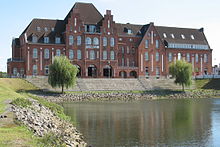Timber and factory harbor
The Holz- und Fabrikenhafen is a public port on the Weser in Bremen - Walle , which was created from 1891 for the landing of wood and grain. It belongs to the Überseestadt district established in 2009 and is part of the urban development project of the same name for the old port areas in Bremen.
description
The port has a harbor basin around 1500 meters long and an average of 80 meters wide , which is connected to the Lower Weser via the grain port and a turning basin . The water depth is between 5.5 and 6.5 meters below sea chart zero . The port is open to the tide with a mean tide low water of 30 cm and mean tide high water of 450 cm above chart zero. In 1960 the port had 6 harbor cranes .
The southern basin bank of the port was originally intended for the timber trade, while industrial companies sprang up on the northern bank of the basin. In the initial phase, the port was called a canal because of the narrowness of the port basin and there was no quay wall, only an embankment. So the new port residents could design their own area.
At the head end of the harbor is the building complex of the customs office Holzhafen and fire station 5 Bremen , which was built in 1907 according to plans by the architect Ludwig Beermann from the building authority in Bremen . Today there is a restaurant in the former car hall, while the other rooms are used as offices.
history
The forerunner of the Holz- und Fabrikenhafen was a port on the Woltmershauser Canal, which became too small at the end of the 19th century due to the demand for European and overseas timber. As early as 1888, the Bremen Chamber of Commerce requested new handling and storage areas for the timber trade. The Bremen council designated an area on Waller Wied for the construction of a new harbor basin. In 1891/1892 the port was completed and the commercial areas were soon occupied, mainly by mills. From 1899 there was further work, in which the north bank of the port was increased by the construction of the Cuxhavener Straße. In 1902 bank construction measures followed and in 1906 the fire fighting bridges on the south bank were raised.
Today the port area is an extensive industrial and commercial area with around 40 resident companies. Port operations are in decline. While around 1,100 ships arrived in 1991, there were only just under 600 in 1998. Most of the companies in the port area are no longer served by ships, but by trucks.
Shipping companies and mills are mainly based on the factory bank. Larger companies are the Rolandmühle with siding of the Bremische Hafeneisenbahn , the Hansa Mühle and the fishmeal manufacturer J. Müller. The Hag coffee company , whose building complex is now an industrial wasteland, was also based here. On the south-western side of the harbor there are now only a few companies in the timber trade and wood processing industry.
literature
- Herbert Schwarzwälder : Timber and factory harbor. In: Das Große Bremen-Lexikon , p. 404.
- Timber and factory harbor. In: Klaus Schlottau u. a. (Ed.): The Bremer Überseehafen. 2nd Edition. Edition Temmen , Bremen 2005, ISBN 3-86108-632-8 .
- Cecilie Eckler-von Gleich: The Überseestadt. The wood and factory harbor. In: Hartmut Roder , Hartmut Schwerdtfeger (Hrsg.): The future of the Bremen ports. Übersee-Museum Bremen (Rasch), Bramsche 2014, ISBN 978-3-89946-235-7 , pp. 165–166.
Web links
- Description of the port with photos at Deichkilometer.de
- Description of the port with photos from 2009
Individual evidence
- ↑ Rough information according to water level, Bremen-Oslebshausen. bsh.de, accessed on November 30, 2017 .
Coordinates: 53 ° 6 ′ 7.5 ″ N , 8 ° 45 ′ 54 ″ E


